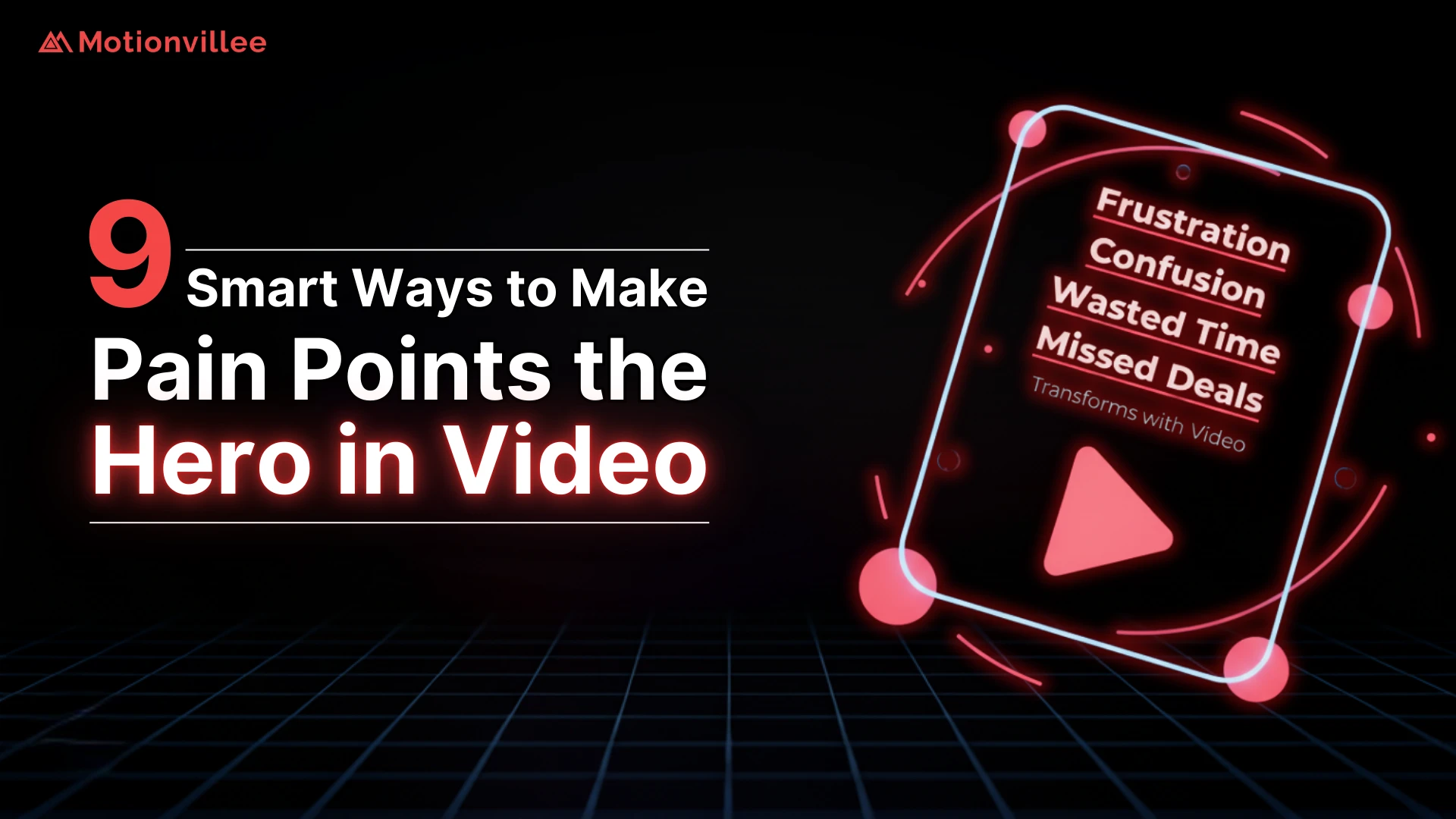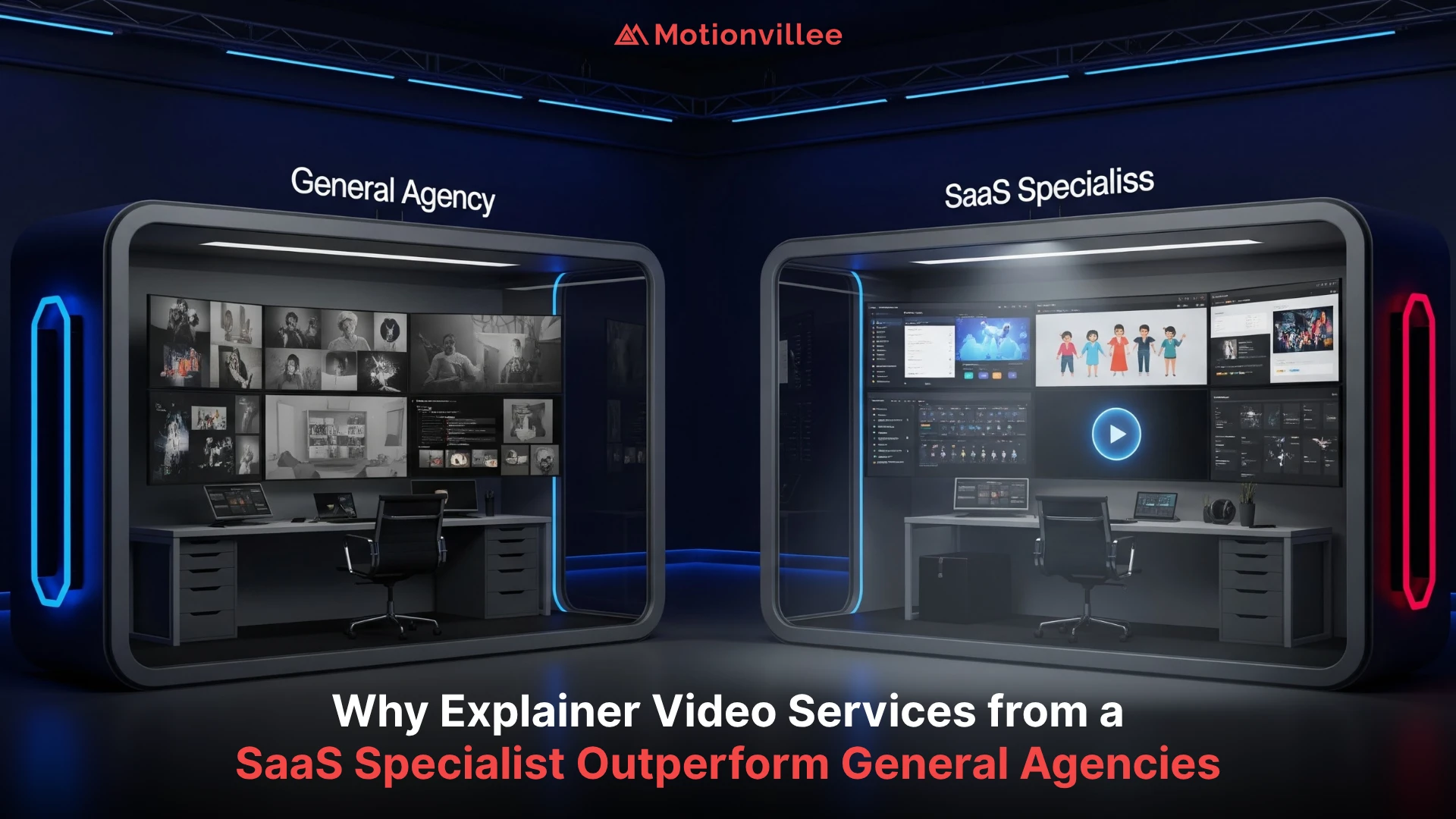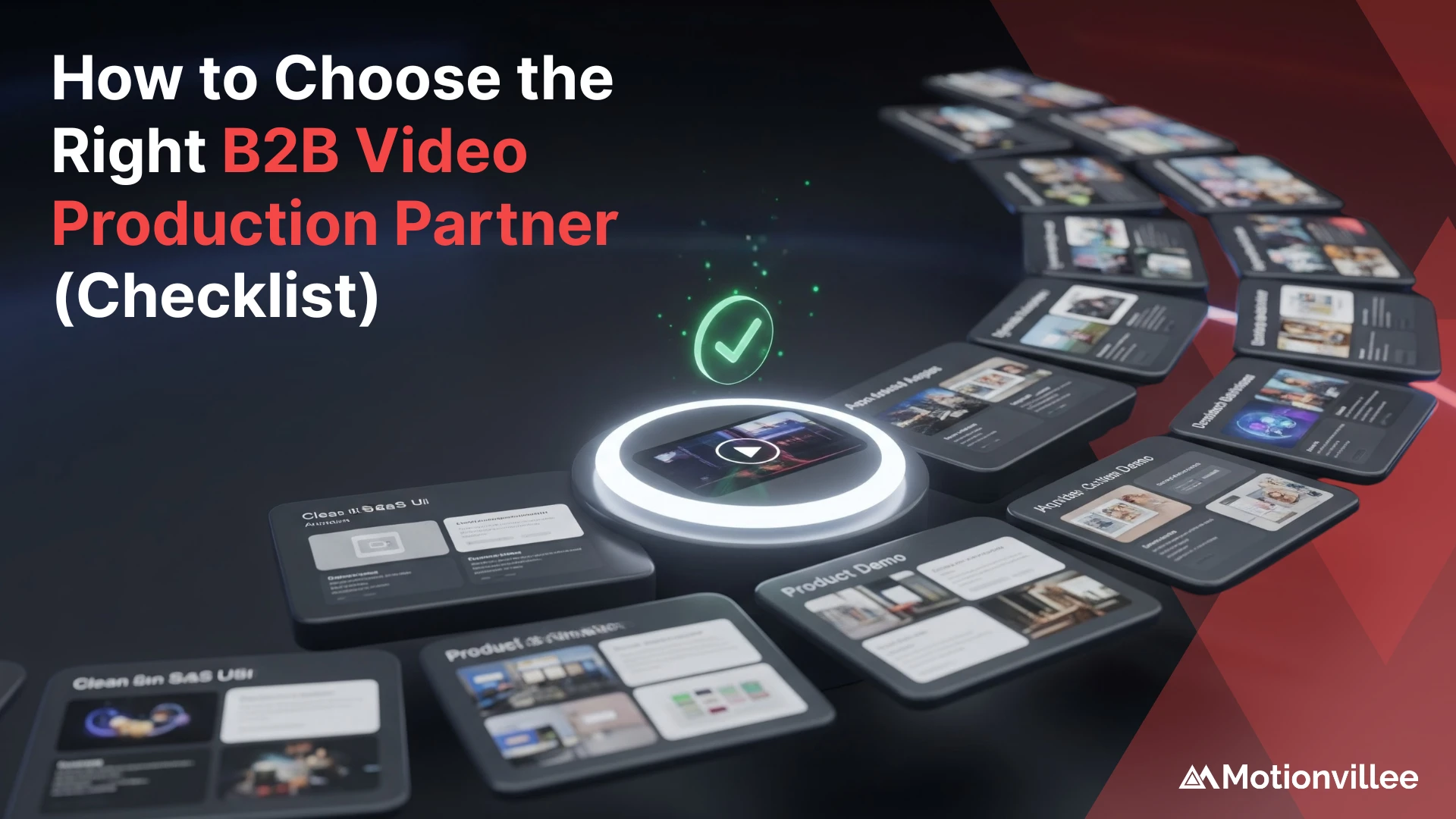Why should B2B videos focus on customer pain points?
B2B videos should focus on customer pain points in B2B video because they connect faster, build trust, and drive decisions more effectively than product feature lists.
When a prospect sees their challenge clearly reflected on screen, they feel understood. This creates an instant bond of relevance, which feature-driven content often fails to achieve. Highlighting pain points also makes the solution more impactful since the audience sees the problem first before the fix.
Effective video storytelling for B2B relies on empathy, not just explanation. By putting pain points at the center, companies show they understand customer struggles and care about solving them.
For Motionvillee, producing videos that spotlight pain points ensures content is clear, relatable, and ROI-driven. Working with experts in Explainer Videos helps brands shape videos that resonate with buyers at every stage of the journey.
What are customer pain points in B2B marketing?
Customer pain points are the specific challenges businesses face that directly impact revenue, efficiency, or growth.
These issues go beyond minor frustrations. They are problems that delay sales, slow operations, or reduce margins. Understanding them is the foundation of creating effective B2B marketing videos.
Common types of customer pain points include:
- Financial pain points: High costs or poor ROI from current solutions.
- Process pain points: Inefficient workflows or manual tasks that slow progress.
- Productivity pain points: Tools or systems that fail to scale with growth.
- Support pain points: Lack of training, guidance, or customer service.
For example, CFOs often struggle with rising costs, CMOs with low campaign effectiveness, and COOs with broken processes. By framing videos around these B2B customer challenges, you show buyers that you understand the real barriers blocking success.
Using B2B Videos, Motionvillee transforms these challenges into structured stories that start with pain, guide viewers toward solutions, and end with measurable business outcomes. This makes the message not only clear but also actionable for decision-makers.
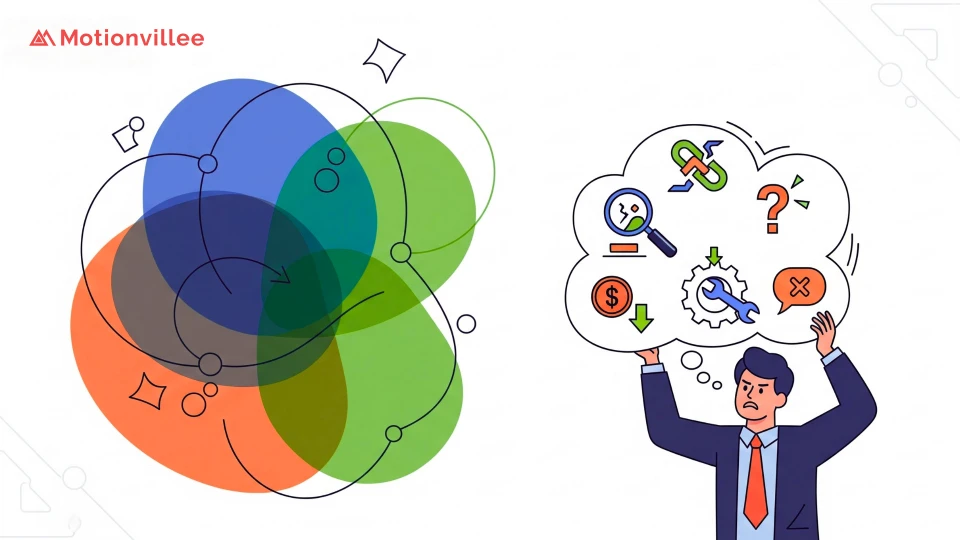
Why should customer pain points be the hero of your video?
Customer pain points should be the hero of your video because they make the story empathetic, relevant, and memorable.
When a video starts with a pain point, the audience immediately feels understood. This creates emotional alignment before the solution is even introduced. Instead of feeling like they are being sold to, prospects feel like the video is built around their reality.
The benefits of addressing pain points go beyond connection:
- They frame your product as the natural answer to a real problem.
- They simplify complex value propositions by showing the issue first.
- They help buyers see ROI faster by linking pain directly to resolution.
In B2B, showing customer pain points in marketing proves you are not guessing but addressing issues that matter most. This empathy-focused approach ensures your video resonates with multiple stakeholders, from CFOs worried about costs to CMOs concerned with growth outcomes.
Through Brand Explainer Videos, Motionvillee helps companies elevate pain points into the central narrative. By positioning the challenge as the hero, videos create stronger impact, shorten sales cycles, and build trust with decision-makers who expect clarity and relevance.
How can you identify the right customer pain points?
You can identify the right customer pain points by combining research, customer input, and sales insights.
The best way to uncover pain points is to listen to your audience directly. Conducting customer interviews and surveys reveals not only surface-level frustrations but also deeper challenges affecting revenue or efficiency. When customers explain their struggles in their own words, you gain clear direction for shaping your video’s narrative.
Another method is analyzing sales team insights. Sales reps speak to prospects daily and hear objections, hesitations, and recurring problems. This feedback often highlights the exact issues that a video should address to resonate with buyers.
Practical ways to discover how to identify customer pain points include:
- Reviewing customer support tickets for repeated issues.
- Tracking industry forums or social channels for pain discussions.
- Conducting win-loss analysis to see why prospects choose or reject solutions.
For B2B brands, customer research for B2B is not optional. It ensures that the story you build in your video is not generic but precise. When you frame your message around verified pain points, your video feels less like a sales pitch and more like a solution tailored to the viewer’s world.
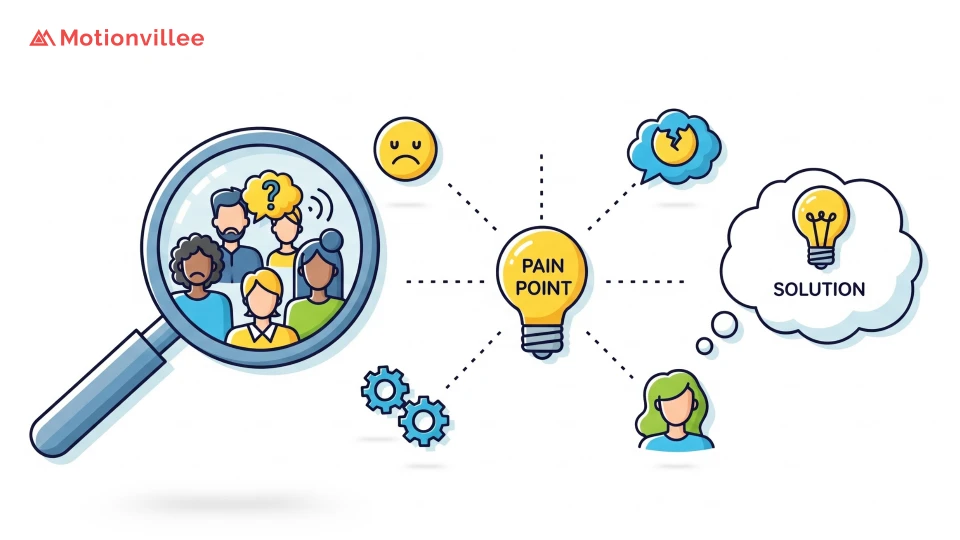
How do you turn pain points into an engaging video narrative?
You can turn pain points into an engaging video narrative by following a clear problem-to-solution flow that keeps the issue central.
The most effective video storytelling with pain points starts by stating the challenge clearly. This creates instant relevance and positions the viewer’s problem as the main character. From there, you guide them to the solution, showing how your product or service resolves that issue step by step.
A simple problem-solution video flow looks like this:
- Problem: Highlight the pain point in a way the audience recognizes.
- Solution: Present your product as the tool that fixes it.
- Benefits: Show the measurable results of solving the pain.
- Action: Guide the viewer to the next step with clarity.
This sequence makes the B2B video narrative easy to follow and emotionally engaging. Instead of talking only about features, you build a story that reflects the customer’s journey from frustration to resolution.
With Motionvillee’s expertise in Product Demo Videos, pain points are not just explained but visualized in a structured, relatable way. This ensures the narrative keeps decision-makers engaged and convinced.
Can real customer stories strengthen the impact?
Yes, real customer stories strengthen the impact because they make pain points relatable and add proof.
When prospects see others with similar challenges, they connect faster. Customer testimonial videos allow real voices to explain how a solution addressed their pain points, which feels more authentic than brand claims. This credibility is essential for B2B decision-makers who want evidence before committing.
Case studies are another powerful tool. A case study storytelling video can outline the challenge, the solution, and the outcome in a way that highlights ROI. For example, showing how a company reduced costs or improved compliance through your product creates trust and urgency.
The best proof in B2B video combines both approaches:
- Testimonials that show the human side of solving pain points.
- Case studies that provide numbers, benchmarks, and ROI impact.
Motionvillee applies these principles in Sales & Marketing Video Production, ensuring that customer stories are not just testimonials but persuasive narratives that validate the solution. This balance of emotion and proof keeps buyers engaged and confident in moving forward.
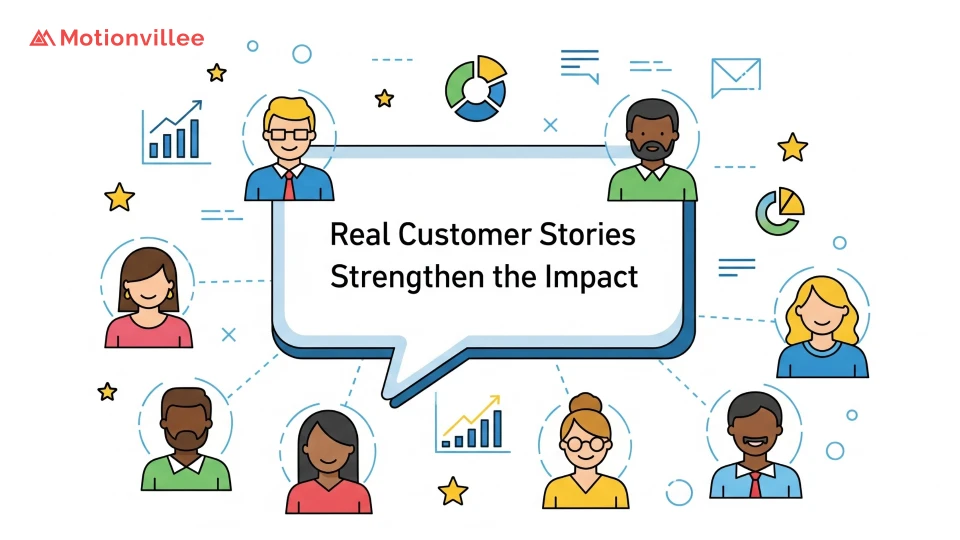
How should visuals highlight customer struggles?
Visuals should highlight customer struggles by making pain points clear, relatable, and easy to understand.
Words alone often fail to capture the weight of a challenge. Visuals for B2B video bring pain points to life by showing the frustration of broken processes, wasted time, or financial loss. When decision-makers see these struggles represented visually, they connect more strongly with the message.
Using motion graphics for pain points allows complex problems to be simplified. For instance, an animation showing dropped revenue bars or clogged workflows communicates the issue faster than a paragraph of text.
Effective visuals should:
- Depict real-world challenges your audience faces.
- Contrast the “before” state of struggle with the “after” state of resolution.
- Reinforce the emotional impact of inefficiency, costs, or delays.
This approach makes challenges relatable and ensures they stick in memory. Through How to Videos, Motionvillee transforms pain points into clear visual stories that not only highlight struggles but also lead naturally into solutions.
How do you balance pain points with positive outcomes?
You balance pain points with positive outcomes by showing the struggle clearly but pivoting quickly to resolution and ROI.
A video that only focuses on challenges risks leaving the audience with a negative impression. By pairing pain points vs ROI, you highlight the cost of inaction but also the measurable benefits of fixing the problem. This balance keeps the tone realistic yet hopeful.
The best way to achieve this balance is to:
- Illustrate the pain point in a way the audience instantly recognizes.
- Transition to the solution with a clear demonstration.
- Highlight the positive outcomes in B2B videos, such as reduced costs, saved time, or better efficiency.
This shift from frustration to value makes the video persuasive without feeling exaggerated. When you turn pain to value, buyers see not only the urgency of solving the issue but also the tangible rewards of choosing your solution.
How can you tailor pain points for different buyer personas?
You can tailor pain points for different buyer personas by aligning challenges with the unique priorities of each role.
Not every executive cares about the same issue. CFO pain points often revolve around cost savings, compliance, and ROI. CMO pain points focus on brand visibility, campaign effectiveness, and customer trust. COO challenges in B2B video typically involve operational efficiency, process improvement, and scaling smoothly.
To make a video resonate with multiple personas:
- Segment your audience into distinct roles.
- Identify the top three pain points for each role.
- Craft visuals and messages that speak directly to those issues.
This approach ensures that no matter who watches, the content feels relevant. A CFO will see the financial benefit, a CMO will see marketing growth, and a COO will see streamlined operations. When pain points in B2B video are tailored, engagement improves and decision-making speeds up.
What role does the call-to-action play in addressing pain points?
The call-to-action plays a key role in guiding buyers to act once the pain point and solution are clear.
A video without a CTA leaves the audience aware of the problem but unsure of what to do next. By adding a strong call-to-action in B2B video, you convert awareness into measurable outcomes. The CTA should be specific, actionable, and connected to the pain point you highlighted.
Examples of CTA examples for customer pain points include:
- “Schedule a demo to see how this reduces costs.”
- “Download the case study to learn how others solved this challenge.”
- “Get in touch with our team to fix these inefficiencies today.”
Well-crafted CTAs turn pain into progress by directing viewers toward resolution. In conversion-focused B2B video, the CTA is the bridge between showing the struggle and delivering the solution. With Motionvillee’s expertise in Get Started Videos, every video closes with clarity and impact.
What is the key takeaway about using customer pain points in B2B videos?
The key takeaway is that making pain points the hero of your video builds empathy, accelerates decisions, and drives measurable ROI.
When buyers see their exact struggles on screen, they connect instantly. This focus makes your content more relevant than feature-led videos and proves you understand the challenges they face. By pairing pain points with solutions and outcomes, your video becomes a trusted guide instead of just a sales tool.
Using customer pain points effectively requires research, storytelling, strong visuals, and clear calls-to-action. Each element works together to move prospects from recognition of a problem to confidence in your solution.
Motionvillee specializes in creating B2B videos that highlight customer struggles and pivot to growth outcomes. If you want to transform challenges into opportunities, Get In Touch with our team to explore how your next video can win trust and deliver ROI.


